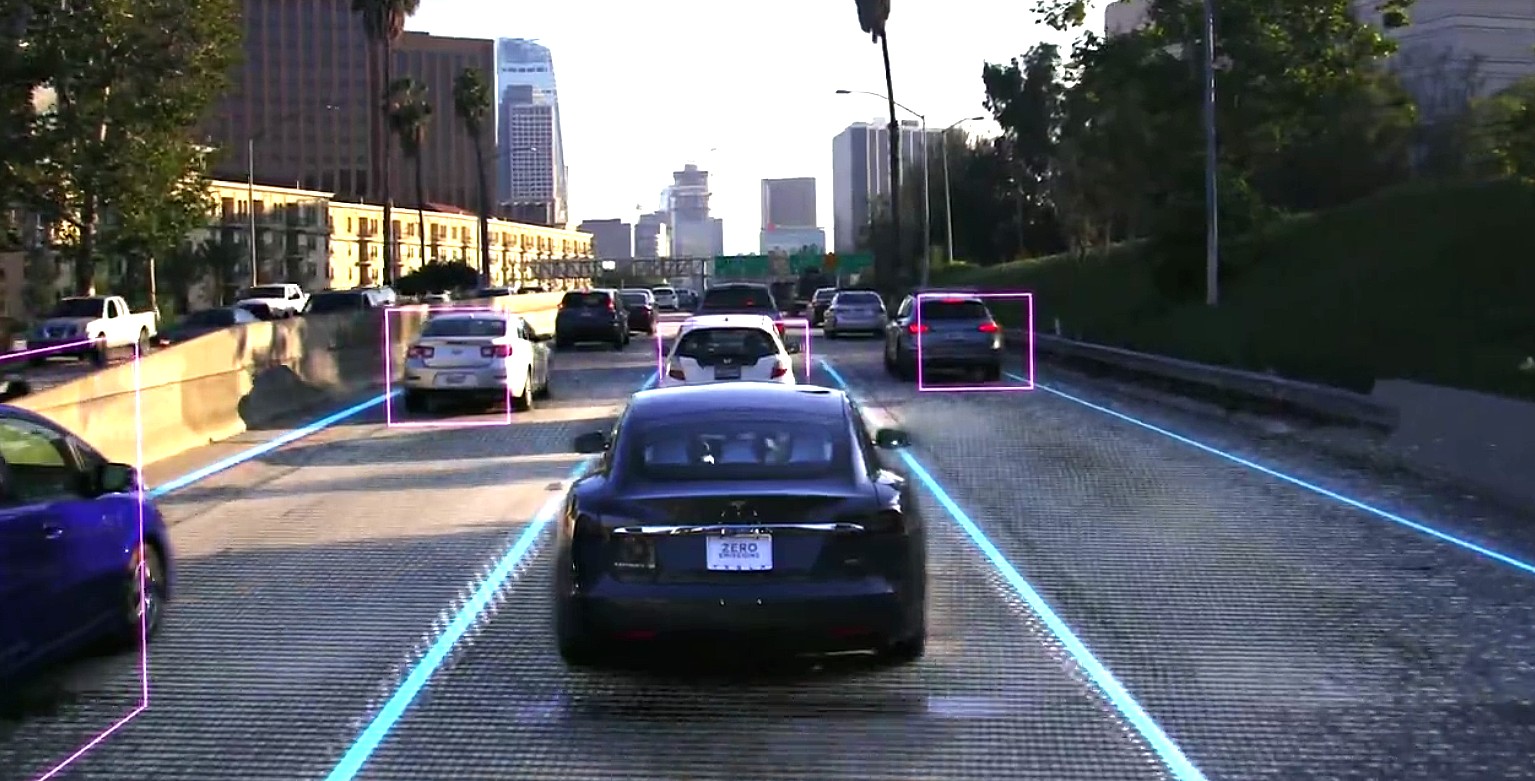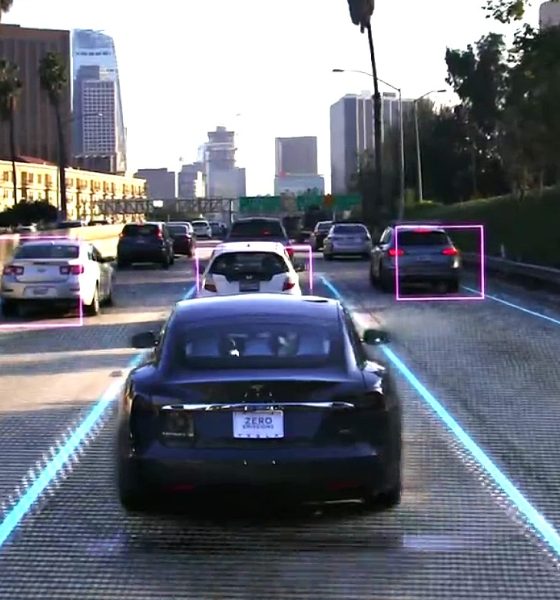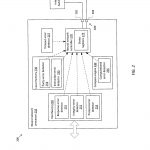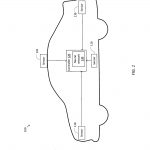A recently published Tesla patent application titled “System and Method for Handling Errors in a Vehicle Neural Network Processor” describes a way to safely handle errors encountered in self-driving software. Rather than risking delays in driving responses that result from input data errors, a signal is sent to ignore the bad information and continue processing as usual. Tesla’s application was published May 23, 2019 as International Publication No. WO/2019/099941.
During self-driving operations in Tesla’s program, streams of real-time input data are received and used to both train its neural network and initiate a vehicle response to what’s being processed. If something in the data is erroneous or causes a delay in processing, the real-world impact can be disastrous if not handled properly. For example, in a fast-moving vehicle, sensor data can become stale very quickly and cause the self-driving software to respond to an environment that no longer exists. This can result in accidents, property damage, injury, and/or death. The solution presented in Tesla’s patent application attempts to avoid such processing delays altogether and thus improves the safety of the self-driving software overall.
Tesla’s patent application describes the issue as follows:
“Some types of errors may cause neural network processor to hang or time out. That is, one or more portions of neural network processor may freeze or otherwise remain inactive for more than a predetermined amount of time. When a timeout error is encountered, [the] neural network processor may cease to provide output data and/or respond to input data. Other types of errors, such as program errors and/or data errors, may cause the output data generated by [the] neural network processor to be corrupted. When such errors are encountered, [the] neural network processor may continue to provide output data, but the result may be incorrect, meaningless, and/or otherwise unusable.”
- Tesla’s self-driving patent application focuses on handling errors found in its neural network. | Image: Tesla/WIPO
- Tesla’s self-driving patent application focuses on handling errors found in its neural network. | Image: Tesla/WIPO
On its face, the concept behind invention may seem somewhat simple, but likely due to the complexity of neural networks and the field of autonomous driving still being fairly new, Tesla’s solution is unique and innovative. At the international review stage in the patent application process, the Examiner found that Tesla’s patent was novel (new) compared to similar neural network inventions already in the field. Specifically, the following was commented in a Written Opinion:
“Although neural network processors are well known in the art, including in the operation of a vehicle, the addition of having the controller signal that a pending data result is tainted, or incorrect, without terminating the execution of the network, improves upon prior art processors by ensuring the computations of the processor in the vehicle continue while ignoring data determined to be in error, and would require a complexity beyond the ordinary skill, and therefore…meets the…criteria for patentability.”
Concerns about Tesla’s Autopilot software were recently hit by a report published by Consumer Reports wherein the consumer advocacy group concluded that Navigate on Autopilot with autonomic lane changes was more of a liability than an asset. The report stated that, since the feature requires drivers to be one step ahead of the system while it is engaged, it still needs improvement, although the same group found Tesla’s autonomous driving software to be more capable than the competition. However, the report was only focused on how Navigate on Autopilot operates when changing lanes confirmation and warnings are disabled, contrary to scathing headlines which lumped all of Autopilot’s features together with the review.
This most recent patent application shows that Tesla is continuously improving its self-driving features, if that wasn’t already obvious from the company’s frequent over-the-air software releases.
At Tesla’s Autonomy Day for investors last month, CEO Elon Musk declared that the company’s Full Self-Driving computer was objectively the “best in the world”. As more information becomes available, such as presentations on Tesla’s technology and in patent applications, Musk’s confidence expressed in his statement becomes more clear. Full Self-Driving is expected to be feature-complete this year and will become publicly available as regulatory hurdles are overcome.

News
Tesla FSD fleet is nearing 7 billion total miles, including 2.5 billion city miles
As can be seen on Tesla’s official FSD webpage, vehicles equipped with the system have now navigated over 6.99 billion miles.

Tesla’s Full Self-Driving (Supervised) fleet is closing in on almost 7 billion total miles driven, as per data posted by the company on its official FSD webpage.
These figures hint at the massive scale of data fueling Tesla’s rapid FSD improvements, which have been quite notable as of late.
FSD mileage milestones
As can be seen on Tesla’s official FSD webpage, vehicles equipped with the system have now navigated over 6.99 billion miles. Tesla owner and avid FSD tester Whole Mars Catalog also shared a screenshot indicating that from the nearly 7 billion miles traveled by the FSD fleet, more than 2.5 billion miles were driven inside cities.
City miles are particularly valuable for complex urban scenarios like unprotected turns, pedestrian interactions, and traffic lights. This is also the difference-maker for FSD, as only complex solutions, such as Waymo’s self-driving taxis, operate similarly on inner-city streets. And even then, incidents such as the San Francisco blackouts have proven challenging for sensor-rich vehicles like Waymos.
Tesla’s data edge
Tesla has a number of advantages in the autonomous vehicle sector, one of which is the size of its fleet and the number of vehicles training FSD on real-world roads. Tesla’s nearly 7 billion FSD miles then allow the company to roll out updates that make its vehicles behave like they are being driven by experienced drivers, even if they are operating on their own.
So notable are Tesla’s improvements to FSD that NVIDIA Director of Robotics Jim Fan, after experiencing FSD v14, noted that the system is the first AI that passes what he described as a “Physical Turing Test.”
“Despite knowing exactly how robot learning works, I still find it magical watching the steering wheel turn by itself. First it feels surreal, next it becomes routine. Then, like the smartphone, taking it away actively hurts. This is how humanity gets rewired and glued to god-like technologies,” Fan wrote in a post on X.
News
Tesla starts showing how FSD will change lives in Europe
Local officials tested the system on narrow country roads and were impressed by FSD’s smooth, human-like driving, with some calling the service a game-changer for everyday life in areas that are far from urban centers.

Tesla has launched Europe’s first public shuttle service using Full Self-Driving (Supervised) in the rural Eifelkreis Bitburg-Prüm region of Germany, demonstrating how the technology can restore independence and mobility for people who struggle with limited transport options.
Local officials tested the system on narrow country roads and were impressed by FSD’s smooth, human-like driving, with some calling the service a game-changer for everyday life in areas that are far from urban centers.
Officials see real impact on rural residents
Arzfeld Mayor Johannes Kuhl and District Administrator Andreas Kruppert personally tested the Tesla shuttle service. This allowed them to see just how well FSD navigated winding lanes and rural roads confidently. Kruppert said, “Autonomous driving sounds like science fiction to many, but we simply see here that it works totally well in rural regions too.” Kuhl, for his part, also noted that FSD “feels like a very experienced driver.”
The pilot complements the area’s “Citizen Bus” program, which provides on-demand rides for elderly residents who can no longer drive themselves. Tesla Europe shared a video of a demonstration of the service, highlighting how FSD gives people their freedom back, even in places where public transport is not as prevalent.
What the Ministry for Economic Affairs and Transport says
Rhineland-Palatinate’s Minister Daniela Schmitt supported the project, praising the collaboration that made this “first of its kind in Europe” possible. As per the ministry, the rural rollout for the service shows FSD’s potential beyond major cities, and it delivers tangible benefits like grocery runs, doctor visits, and social connections for isolated residents.
“Reliable and flexible mobility is especially vital in rural areas. With the launch of a shuttle service using self-driving vehicles (FSD supervised) by Tesla in the Eifelkreis Bitburg-Prüm, an innovative pilot project is now getting underway that complements local community bus services. It is the first project of its kind in Europe.
“The result is a real gain for rural mobility: greater accessibility, more flexibility and tangible benefits for everyday life. A strong signal for innovation, cooperation and future-oriented mobility beyond urban centers,” the ministry wrote in a LinkedIn post.
News
Tesla China quietly posts Robotaxi-related job listing
Tesla China is currently seeking a Low Voltage Electrical Engineer to work on circuit board design for the company’s autonomous vehicles.

Tesla has posted a new job listing in Shanghai explicitly tied to its Robotaxi program, fueling speculation that the company is preparing to launch its dedicated autonomous ride-hailing service in China.
As noted in the listing, Tesla China is currently seeking a Low Voltage Electrical Engineer to work on circuit board design for the company’s autonomous vehicles.
Robotaxi-specific role
The listing, which was shared on social media platform X by industry watcher @tslaming, suggested that Tesla China is looking to fill the role urgently. The job listing itself specifically mentions that the person hired for the role will be working on the Low Voltage Hardware team, which would design the circuit boards that would serve as the nervous system of the Robotaxi.
Key tasks for the role, as indicated in the job listing, include collaboration with PCB layout, firmware, mechanical, program management, and validation teams, among other responsibilities. The role is based in Shanghai.
China Robotaxi launch
China represents a massive potential market for robotaxis, with its dense urban centers and supportive policies in select cities. Tesla has limited permission to roll out FSD in the country, though despite this, its vehicles have been hailed as among the best in the market when it comes to autonomous features. So far, at least, it appears that China supports Tesla’s FSD and Robotaxi rollout.
This was hinted at in November, when Tesla brought the Cybercab to the 8th China International Import Expo (CIIE) in Shanghai, marking the first time that the autonomous two-seater was brought to the Asia-Pacific region. The vehicle, despite not having a release date in China, received a significant amount of interest among the event’s attendees.












